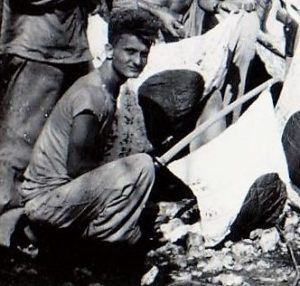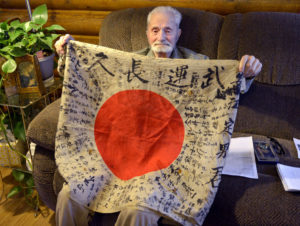
Strombo’s Last Mission
40 Thief Marvin Strombo’s Last Mission.
 Strombo, 1944
Strombo, 1944 Strombo, 2017
Strombo, 2017
As the Marines marched through island after island in the Pacific, the battles became more bloody and more pitiless. On Saipan, the Marines suffered over 16,000 casualties and the 30,000 Japanese warriors garrisoned there fought to the death.
For the conquering Marines, their dead were interred individually with graves marked by white crosses which bore the Marine’s name. Their belongings were sent back to their families in the States.
The Japanese, their bodies badly decomposed, would be dumped into mass graves, doused with quick-lime and bulldozed over with dirt. Signs marking their graves read, “Over 500 enemy buried here.”
With the belongings of the defeated being pilfered by the conquerors, once a Japanese warrior left home, no memory of him would ever return.
On June 26, 1944 , a six-man patrol from the 40 Thieves left camp on a reconnaissance mission deep into Japanese held territory, and be the first US troops to set foot in Saipan’s capital city of Garapan.
On the way into Garapan 19-year old Thief Marvin Strombo acquired a Yosegaki Hinomaru, or “Good Luck Flag,” from a Japanese Captain who had died days earlier in a mortar strike.
A Yosegaki Hinomaru was a sacred gift from one’s family before departing for war, embodying the warrior’s soul. A Buddhist priest would bring a blank Japanese flag to a ceremony where the soldier’s family and friends would sign it with prayers and well-wishes. If he had a child or a niece or nephew too young to write, they would mark it with a little hand print. The soldier carried this flag with him everywhere, specifically into battle as good luck.
For front-line Marines, these flags became the souvenir of preference. The Army and rear echelon troops who trailed the Marines’ advances pilfered helmets, swords and other, bulkier belongings. Whereas the Good Luck Flags, made out of silk, folded up quite small, and more than a dozen could easily be held in a combat pack. Being paid $28 a month, Marines found these flags valuable as barter for booze, weapons and other items of need; fourteen represented one years’ pay.
For decades Marvin Strombo had hoped that the flag he acquired on the road to Garapan could be returned to the family of its rightful owner.
Thanks to a series of articles written in the Missoulian by Kim Briggeman under the tag line Honor among Thieves, the family of the Japanese captain was located.
In August 2017, ninety-three-year-old Strombo made the arduous trip to Japan, kept his promise and delivered Captain Sadao Yasue’s Good Luck Flag to his younger brother, Tatsuya.
Upon receiving the sacred heirloom, Tatsuya held it to his face, inhaled deeply and said, “You have taken good care of my brother.”


